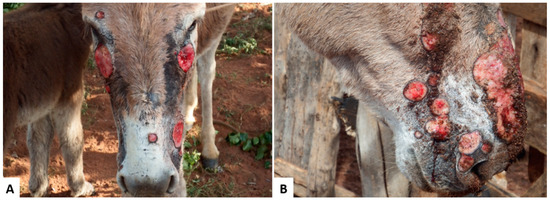1000/1000
Hot
Most Recent

Equids are part of the history of many countries, including Brazil, where they were used in trade routes and expansion of the current states. Several skin diseases affect these animals; however, visibility is higher on horses than on donkeys and mules, which is linked to regional cultural and socioeconomic factors, even resulting in a decline of the world population of these animals. In this context, the objective of this study was to review which skin diseases have been reported in the scientific literature with emphasis on skin pathologies.
Donkeys and mules represent an important share of the world’s equids, totaling about 44 million in recent years, of which approximately 1 million are in Brazil[1][2]. The breeding of these animals is important in developing countries, and their introduction in the territories was quite variable, being associated with the colonial period in South America [3]. The work of donkeys and mules ranges from field work to recreation and entertainment[4], safeguarding socioeconomic importance in many states of Brazil, especially in eastern Brazil.
Many of the phenotypic and physiological characteristics of these animals favor sustainable breeding to increase regional economy. Donkey breeding, however, still presents major challenges in Brazil, which sees their population gradually decreasing over the years[5]. On the other hand, there is a trend toward expansion of the consumer market for meat, milk, and especially donkey skin, given the demand for these products in Asian countries such as China[6].
In this context, the investigation of diseases affecting donkeys and mules becomes important and gives rise to discussions on animal welfare and public health. This is demonstrated particularly in serological studies that show the participation of donkeys and mules in the epidemiological chain of reportable diseases[7][8]. It is furthermore important to highlight that cultural factors may influence the frequency of these diseases, affecting both animal and human health and welfare. Integrating these concepts within the population of an increasingly technological world is perhaps the greatest challenge of sustainable breeding of donkeys and mules today.
Regarding skin diseases in productive animals, the literature lacks studies on dermatopathies and their risk factors, especially in Brazil. Until recently, retrospective studies in ruminants and equids[9][10] have been highlighted in the country, whereas studies on donkeys are still incipient[11][12]. In this context, the objective of this study was to present a literature review on skin diseases in donkeys and mules.
To identify the main dermatopathies diagnosed in equids today, this study consists of a literature review containing the main studies on equine medicine and breeding, in which four major themes were initially proposed to direct the bibliographic research: (a) the use of donkeys and mules in Brazil and in the world; (b) the main diseases of donkeys and mules; (c) skin diseases diagnosed in donkeys and mules; and (d) equid dermatopathies in northeastern Brazil.
Much of the attention given to donkey skin is due to the commercial value in the international market. In this context, similar to bovine leather, skin lesions may depreciate the final product and interfere with quality. In Brazil however, reports of integument disorders in donkeys and mules are little reported when compared to North American, European, and Asian countries. The low value attributed to these animals in the northeastern rural communities, associated with particularities of the species regarding clinical presentation of some diseases, probably impact the owner’s decision not to take these animals to the veterinarian, resulting in many diseases being underdiagnosed in the region.
A study in the semiarid region of Paraíba State reported that 258 donkeys and mules seen in 10 years presented integumental diseases as the main causes of consultation (88 cases), mainly traumatic wounds, sarcoids, and abscesses in donkeys and traumatic wounds, squamous cell carcinomas, and habronemiasis in mules. A very important finding raised in this study was that most diseases diagnosed could be linked to mistreatment or lack of attention to these animals[11], a factor associated to the cultural habits of many owners.
In the same year, another retrospective study exclusively on equid skin diseases in the semiarid northeast was published[11]. According to this study, only one case of pythiosis was reported in donkeys in the northeast, which was subsequently approached regarding clinical, epidemiological, pathological, immunohistochemical, and molecular aspects[13]. According to the authors, the pattern of the lesion was similar to cases of pythiosis in cattle, and the origin of the disease was attributed to grazing in flooded areas, similarly to what is described in equines.
Other diseases that deserve to be highlighted, despite the less expressive diagnosis, are photosensitizing and allergic diseases, recently diagnosed in donkeys and mules in the northeast of Brazil. A case of allergic dermatitis to a Culicoides bite was reported in the state of Pernambuco, characterized by crusted papule and pruritic skin lesions with a clinical progression of two years. A very important finding highlighted in this study was the difficult clinical diagnosis due to similarities with other equid dermatopathies[14].
Primary photosensitization caused by Froelichia humboldtiana in equids have been reported in the semiarid region of Brazil, affecting donkeys and mules. This condition was described as exuberant, ulcerated lesions, with abundant serous exudation and crusts, alopecia, erythema, edema and areas of necrosis (Figure 1), especially in face, croup, and withers, accompanied by intense itching. The lesions were also associated with myiasis and secondary infections and, in many cases, due to the impossibility of treating the wounds, there was high mortality in the herd. The disease occurs at the end of the rainy season in pastures highly invaded by F. humboldtiana. Animals usually recover after their removal from areas invaded by this plant[15].

Figure 1. Donkeys naturally poisoned by Froelichia humboldtiana. (A) Multiple skin ulcers caused by secondary self-mutilation to intense itching; (B) Multiple and extensive ulcerated wounds, that drained serous exudate.